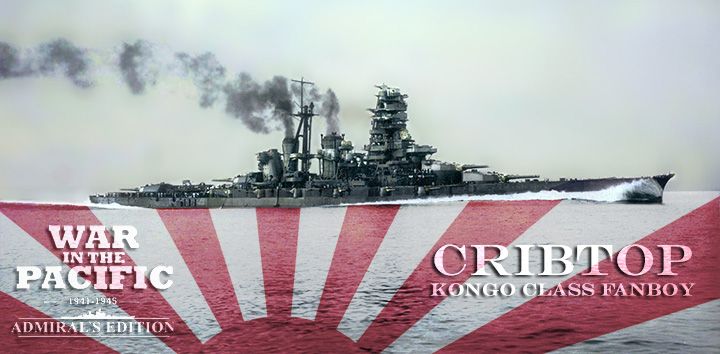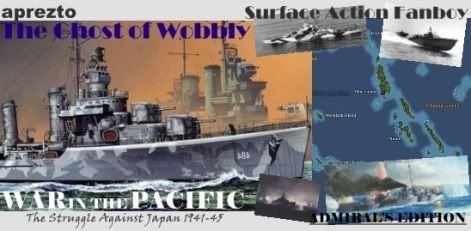Cuttlefish
Posts: 2454
Joined: 1/24/2007
From: Oregon, USA
Status: offline

|
April 10, 1942 – April 25, 1942
With oil and fuel flowing freely towards the Home Islands and the vital conquests in the DEI coming to a close Japan now turns its main attention to the two operations that will consume most of its attention and military resources for the next several months: the invasions of Suva and Chittagong.
DEI: Die, Java, Die. As always, the bulk of Java is easily overrun but reducing the final Allied strongholds is a pain in the patookis. Batavia still holds on, as does Soerabaja and the bases at the eastern end of the island. Two more divisions are en route (one from Luzon, one from Mindanao) to join the four already on the island. Their arrival should help bring the campaign here to a swift conclusion. Five of the divisions will join a sixth already in Singapore for the invasion of Chittagong.
Koepang fell quickly and is already being built into a major base. There are a few Allied garrisons in the region that have been bypassed and still need to be taken, including Iloilo, Cebu, and Ambon.
Japanese carriers destroyed a fair amount of shipping in the Darwin area. It will be months before the final toll is known but at a minimum Japanese carrier planes sank two TKs, three xAPs, an xAK, two xAKLs, an AVP, and an AR. Many other ships were left with “heavy fires, heavy damage.” I believe Charbroiled sent his own carriers back down around Australia once they were discovered, but I do not have concrete intelligence about this, just some inconclusive sub sightings near Perth.
Burma: Die, Burma Corps, Die. The Allies have major forces contesting the Japanese advance up from Moulmein. Thus the planned landing at Chittagong, the object of which is to destroy as much of the British army in Burma as possible. The object of destroying the British, in turn, is to delay the usual massive Allied counter-offensive which usually gets rolling in the spring of ’43. Burma is a dog’s dinner for Japan in AE, with a bad defensive set-up and an enemy who can push huge forces through the jungle at will. Thus my object is to destroy enemy forces there and buy time while fortifying the much more defensible Thai frontier.
China: Going Nowhere, Slowly. Combat continues south of Sian but without further Japanese gains. I may yet be able to wear down the Chinese defenders but I may also need to admit that a direct thrust against Sian will not work. I may want to consider probing elsewhere, against Changsa perhaps, to see if I can find a weak point.
Pacific: Operation Wood Chipper Commences. All necessary forces for the invasion of Fiji are now in place. Troops are beginning to board transports at Port Moresby and Truk. This will take a few days. And then we will see what happens.
I have not had many opportunities to invade a base so deep in enemy territory. But I’ve been on the receiving end of more than a few invasions. So I’ve been asking myself in what ways can invasions fail and what I can do to prevent it from happening to me.
Reason #1: Insufficient forces. This usually stems from bad intelligence information and it is a worry, since Glens are not the most efficient recon planes in the Japanese arsenal. But I have three divisions planning for Suva with a fourth division in reserve, which should be sufficient even if there are three times the 10,000 or so troops that I believe to be there.
Reason #2: Inadequate logistics and planning. I have an advantage here in that my troops are able to land at weakly-held Nadi. This will give me a place to dump supplies while my troops march down the major road to adjacent Suva. A dedicated supply convoy will join the invasion TFs, which will also have their own supplies. Headquarters, engineers, and base force troops will also land here. The divisions involved should all be at around 50% prepped for Suva when they finally get there.
Reason #3: Losing control of the sea and air around the invasion site. The Combined Fleet and Kido Butai will be there. Allied surface forces have taken a pounding in the early going so far and should not be a factor but Allied carriers and land-based air are a major worry. It will be up to Kido Butai to fend them off. Since forcing the Allied carriers to attack is a major goal of this operation this is to be looked at as an opportunity, not a obstacle. Still, you are rolling the dice whenever carriers clash in AE. I am looking for the Decisive Battle: will I get a Midway instead?
If it all works as planned I will then begin pounding the Allied bases in the Solomons, New Hebrides, and New Caledonia prior to invasion. A huge number of Allied troops could be lost if I am successful. The Allies can replace their losses eventually, of course, but the idea is to keep hitting them at a favorable loss ratio (which for Japan means losing next to nothing in return for huge gains) and forcing them to delay and delay their counter-offensive.
Production: Building the Sinews of War. So far Japan’s war machine is still running at full steam, with good stocks of fuel, oil, and resources in the Home Islands. I have made some improvements in this regard over my previous two games and am fairly pleased with the results so far.
Resources: I am running resource convoys from Hakodate, Sakhalin, Port Arthur, and Formosa. There are about twenty-five convoys involved, all of them with names like “Port Arthur resource #5” or whatever. These are all composed of slower xAKs and carry between 25K and 30k of resources per trip. I don’t ship resources from further afield on a regular basis, though supply convoys to more distant bases always pick up a load of resources for the return trip rather than sail back empty.
Fuel: Fuel stocks in the Home Islands remain at high levels because I have managed to avoid sending even a drop of fuel elsewhere. The first fuel shipments from the DEI went to Hokkaido, which tends to run out first; subsequent shipments are going to Nagoya and Osaka. About half of the available fuel, however, is going to the Pacific: Truk, Rabaul, and Kwajalein. The invasion of Fiji is going to consume a lot of fuel and I don’t want to be caught short. I figure I will need at least 100k of fuel, 150k would be better.
Oil: Oil levels in Honshu have hardly dropped at all since the start of the war. This is very encouraging. It means Japan’s economy is in the pink of health and that I will have plenty to divert to secondary industrial centers such as Port Arthur.
Industry: With the economy running well I have been able to expand production here and there. Some airframe production (Kates, Zeros, Oscars) has been expanded while many other types (Sonia, Nate, Jake, etc.) have been shut off once adequate stockpiles were reached. Nakajima Ha-35 production has been increased.
As far as I can tell the major drains on HI levels are engine production, shipyards, and armaments. Armament levels are at 85k; once they reach 100k I will shut off most production until it is needed again. I am going to leave merchant shipyards going for now, but they are next. Engine production will be monitored and types with excess stockpiles will also be shut down until needed. My goal is to have 1 million HI stockpiled by the end of ’42, something I have not come close to achieving in either of my previous games.
|
 Printable Version
Printable Version



























 New Messages
New Messages No New Messages
No New Messages Hot Topic w/ New Messages
Hot Topic w/ New Messages Hot Topic w/o New Messages
Hot Topic w/o New Messages Locked w/ New Messages
Locked w/ New Messages Locked w/o New Messages
Locked w/o New Messages Post New Thread
Post New Thread